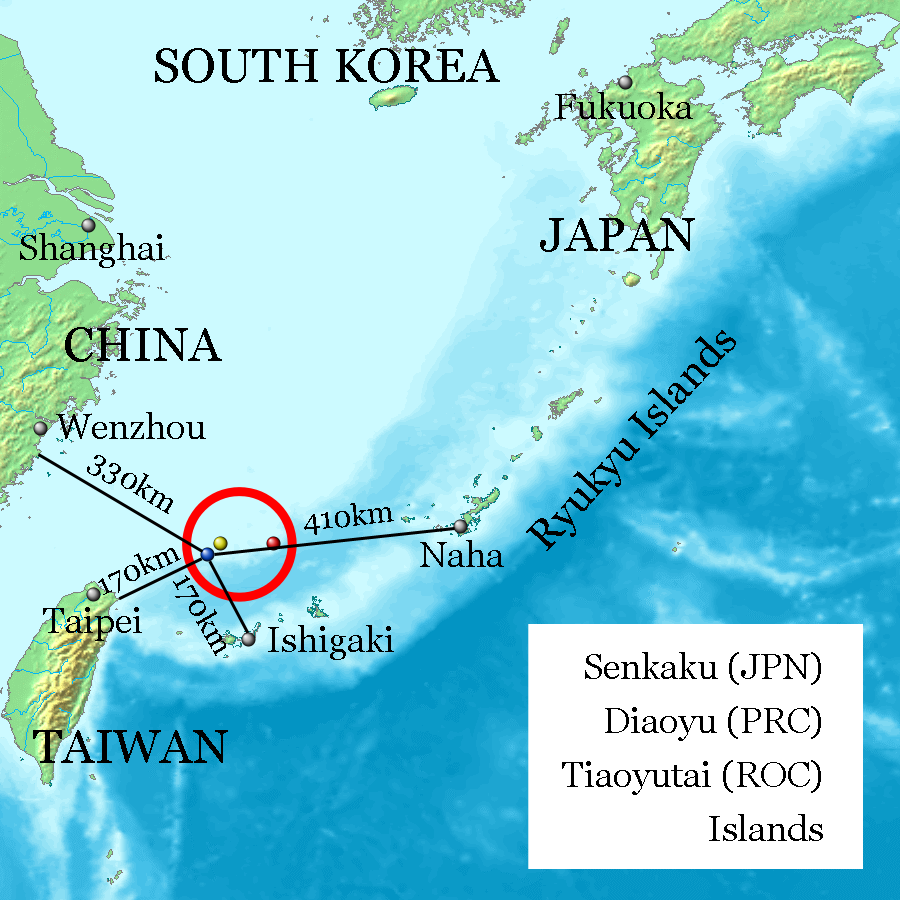The Big Picture: Senkaku-Diaoyu Islands Dispute | 23 Jul 2020
What is the dispute about?
- A long-standing controversy over the islands’ ownership has periodically soured relations between China and Japan.
- Two years earlier, a report highlighting the potential for oil reserves in the area prompted China to reassert its territorial claims over the islands. Japan does not recognise China’s claims nor the existence of a dispute over the islands’ sovereignty.
- More recently there has been a flare-up in the region. The Japanese government said that it had protested to China regarding a set of names recently assigned by Beijing to seabed zones in the East China Sea, including the Senkaku- Diaoyu islands.
Geographical location
- The Diaoyu archipelago (known as the Senkakus in Japanese) is an uninhabited chain of islands in the East China Sea claimed by China, Taiwan and Japan.
- The Japanese-administered island chain, formed by five islets and three barren rocks, covers an area of 7 square km. It is located about 200km southwest of Japan’s Okinawa island and a similar distance northeast of Taiwan.
- Senkaku islands are a part of the Ryukyu chain of islands.
Okinawa Island
- The center of the former Ryukyu Kingdom, Okinawa Main Island is by far the largest and most populous island in Okinawa Prefecture and the regional transportation hub.
- The prefectural capital Naha and most of the US military bases are located on Okinawa Honto.
- While much of the central part of Okinawa Honto is urbanized, the southern tip of the island is less densely populated, and the northernmost Yambaru area remains mainly covered by forested hills and small fishing and farming villages
History of Dispute
- China says that the islands have been part of its territory since ancient times, serving as important fishing grounds administered by the province of Taiwan.
- Taiwan was ceded to Japan in the Treaty of Shimonoseki in 1895, after the Sino-Japanese war.
- Japan annexed the archipelago following China’s defeat in the first Sino-Japanese war from 1894 to 1895. Yet the islands were left out of the Treaty of San Francisco at the end of the second world war that returned to China most of the territories previously occupied by Japan.
- China says, when Taiwan was returned in the Treaty of San Francisco, the islands should have been returned too.
- Under the terms of Japan’s surrender, the island chain was controlled by the US until 1971, when it was returned to Japan along with Okinawa and other surrounding islands.
Cause of the dispute
- Oil exploration: The areas around these islands were found to be the possible bearers of oil and gas; which caught the Chinese interest.
- But, the main cause of China claiming right over the islands is not the availability of oil but to establish their supremacy and dominance and they are pursuing it by the nine-dash line in the south china sea.
- Shipping lanes: Abundant fishing resources can be found nearby, as can important shipping lanes used by Japan, South Korea and China for energy imports.
Latest developments
- The Chinese have been drilling for oil and gas near the Senkaku island, the Japanese have accused them of stealing oil from the Exclusive Economic Zone (EEZ) of Japan.
- The Japanese assembly changed the name of the southern Japan area containing the Senkaku Islands from "Tonoshiro" to "Tonoshiro Senkaku". China in retaliation, assigned names to the seabed zones in the East China Sea.
- Recently, there was a standoff between the Japanese and Chinese coast guard vessels. The Chinese coast guard vessels didn’t back off causing protest in Japan.
- The defence of the Senkaku/Diaoyus has been a priority for Japan even in the past few years.
- Japan has established new military bases nearby to protect the islands. The Japan Self-Defense Force (JSDF) has also been building up its marines and drilling them on island warfare.
- U.S stand: The US and Japan forged a security alliance in the wake of World War II and formalised it in 1960. Under the deal, the US is given military bases in Japan in return for its promise to defend Japan in the event of an attack.
- This means if conflict were to erupt between China and Japan, Japan would expect US military back-up.
- The US has been silently watching the incident but refused to take any action. The US is not willing to interfere between China and Japan.
- The US is worried about China’s intrusion into the Pacific ocean which might be a direct threat to the US.
- India’s Stand: By supporting Japan against Chinese Policy of Incremental Expansionism, India can diplomatically strengthen its position over Galwan Valley.
Exclusive Economic Zone (EEZ)
- Each coastal State may claim an EEZ beyond and adjacent to its territorial sea that extends seaward up to 200 nm from its baselines.
- Within its EEZ, a coastal state has:
- Sovereign rights for the purpose of exploring, exploiting, conserving and managing natural resources, whether living or nonliving, of the seabed and subsoil.
- Rights to carry out activities like the production of energy from the water, currents and wind.
- Unlike the territorial sea and the contiguous zone, the EEZ only allows for the above-mentioned resource rights. It does not give a coastal state the right to prohibit or limit freedom of navigation or overflight, subject to very limited exceptions.
Way Forward
- China’s border and maritime aggression are increasing. The Senkaku/Diaoyu issue highlights the more robust attitude China has been taking to its territorial claims in both the East China Sea and the South China Sea.
- Japan and China must cooperate with each other against Chinese aggression in Indian ocean and East China sea. This would be mutually beneficial for both the countries. India should take full advantage of Japanese desire to encounter China in this region.

